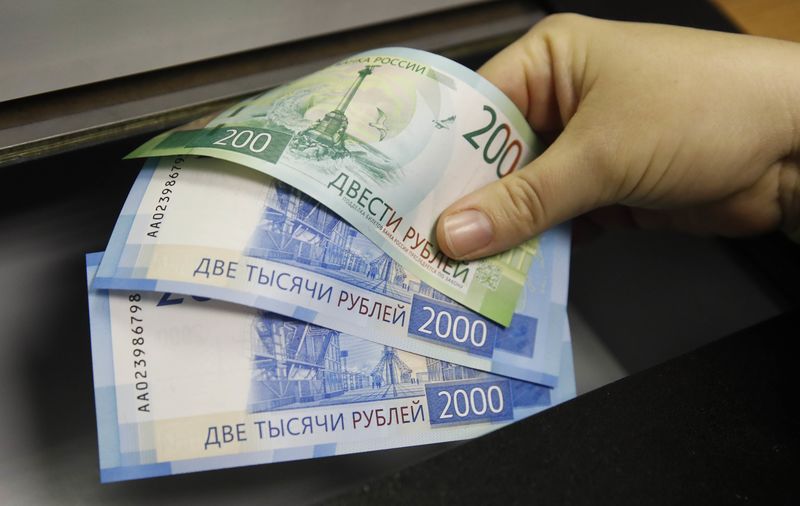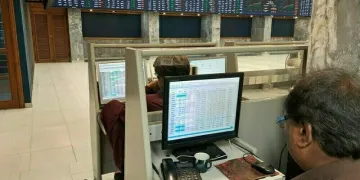 © Reuters. FILE PHOTO: A woman holds new 200 and 2,000 rouble banknotes in a bank in Moscow
© Reuters. FILE PHOTO: A woman holds new 200 and 2,000 rouble banknotes in a bank in MoscowBy Katya Golubkova and Andrey Ostroukh
MOSCOW (Reuters) – The ruble touched its weakest since late 2016 before recovering a small part of recent losses as a sell-off of Russian assets, triggered by more U.S. sanctions, extended into Tuesday with the reaction from local authorities still muted.
The United States on Friday imposed sanctions against 17 senior government officials plus seven oligarchs and 12 companies they own or control, sparking an investor exodus.
Designed to punish Moscow for its alleged meddling in the 2016 U.S. presidential election and other “malign activity,” their spread far beyond the targeted companies.
The ruble slid to 63.95 versus the dollar, its weakest since early December 2016, and eased to 78.77 against the euro, a level last seen in early April 2016. It later edged up from lows as the price of oil, Russia’s main export, rose.
Bonds took a hit as well. Yields on 10-year OFZ treasury bonds, which move inversely to prices, rallied to 7.55 percent, a level last seen in late 2017 ().
They came under added pressure from a proposal by two U.S. congressmen to impose sanctions on holders of Russian debt.
Rapid moves on the bond market, where OFZ treasury bonds have recently been in strong demand among foreigners thanks to their relatively high returns, prompted the finance ministry to cancel its weekly OFZ auction for the first time since 2015.
“The trajectory of Russian assets is expected to be extremely volatile and dependent on incoming news,” Rosbank, a subsidiary of Societe Generale (PA:), said.
JP Morgan’s EMBI+ bond index for Russia, which tracks returns from trading a number of Russian bonds fell sharply to 824.1, a level last seen in late 2016, from around 861 before the sanctions <.jpmeprusr>.
BOUNCING OFF LOWS
The Russian government said it would minimize the fallout from the U.S. sanctions and dismissed sharp falls as short-term volatility, saying time was needed to adjust to the new curbs.
As oil prices headed higher, Russian assets rebounded but remained more volatile than usual. Brent crude futures rose 1.8 percent to $69.86 per barrel ()
The ruble was at 62.62 against the dollar as of 1353 GMT, still down 3.3 percent
Analysts said the sell-off could provide investment opportunities after the dust settled.
The rouble-traded MOEX share index () was 3.8 percent higher at 2,170 after falling 8.3 percent on Monday.
Shares in EN+ Group, which is on the sanctions list and manages tycoon Oleg Deripaska’s aluminum and hydropower assets, were up 7 percent on the London stock exchange (L:) after plummeting 54 percent in the two preceding days.
Shares in Rusal, the world’s second-biggest aluminum producer and also on the sanctions list, were up 5.2 percent on the Moscow Exchange (MM:) after losing more than 34 percent of their value in the two trading days.
“While the general backdrop remains uncertain and the threat of further sanctions is unclear, we believe the Russian market is near a temporary floor,” Alfa Bank said in a note.
“We note that the fundamentals surrounding the Russian market remain mostly unchanged and that Russian equities still provide among the healthiest dividend returns globally. We would thus ignore the current jitters and buy into the current weakness, particularly with dividend season almost upon us.”
The economic impact of the new sanctions was also unclear and analysts said it was too early to revise forecasts.
“We tend to believe that the impact on economic growth ought to be fairly limited given that Russia has already deleveraged, and economic policies of recent years ensured stabilization and de-risking of the domestic economy,” Renaissance Capital analysts Oleg Kouzmin and Daniel Salter said in a note.
Source: Investing.com


























